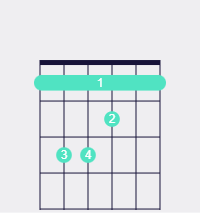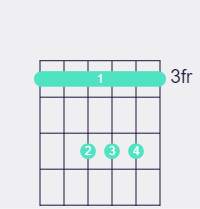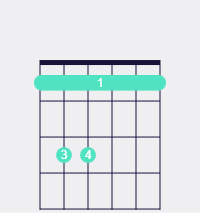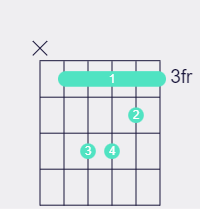
Today we’re going to talk about the hardest guitar chords every beginner should master.
There is no question that some guitar chords are harder to play than others. However, a basic understanding of music theory is a massive help toward learning chords in an easier way.
After all, chords are connected. In other words, the notion that there are five thousand different chords to learn is quite misleading. In reality, most chords are an extension, combination or mix of other simpler ones. Knowing how harmony works is essential to unlocking the amazing world of chords.
Before we jump in, please check out Roadie Coach. This is a fantastic tool that attaches to your instrument and helps you become a better musician. Working together with an app, Coach gives you personalized feedback and captures your performance via a high-quality microphone. Without further ado, here are the hardest guitar chords every beginner should master.
F Chord
The F chord is typically the first major test in a beginner’s journey. Many give up after attempting to learn the F chord. This is because it is a bar chord.
If you have never played a bar chord before, the F is going to take extra patience and resistance to frustration. As the first bar chord that is typically taught, the F chord takes longer to master than open string chords. We’re talking about days, sometimes weeks of continuous practicing in order to play it well.

To play it, place your index finger across the six strings of the first fret. In other words, place a bar on the first fret. Then, place your middle finger on the third string second fret, ring finger on the fifth string third fret, and pinky on the fourth string third fret.
The F chord shape can be moved up and down to create other major chords. For instance, if you move the F chord up two frets, you will have a G chord. Move it up two more frets and you get an A chord.
This will unlock all basic major chords that start with the bass on the sixth string, as you can just move the basic shape up and down the neck.
Since You’re Here…

Fast-track your guitar learning journey, with the Ukulele and Guitar Coach App by Roadie Music. (iOS | Android)
This is the first and only AI-based guitar and ukulele learning app that listens to you play and guides you with customized feedback, just like a music teacher would. Coach will mainly help you :
- Discover & master ANY chord
- Practice strumming patterns
- Learn any song from scratch & at you OWN pace
- Get personalized feedback on skills that need improvement
C chord (barred)
The open string C chord is among the first ones a beginner learns. It is relatively easy and involves only three fingers. However, the barred C chord is one of the hardest guitar chords for beginners. Although it involves the same notes but is rearranged (in a different order), this chord is more challenging to play.
That is because we also need a bar in order to play it.

Place your index finger across the strings on the third fret. Then place your middle finger on the fourth string fifth fret, ring finger on the third string fifth fret, and your pinky on the second string fifth fret.
It is important to note that, unlike the F chord, we are not going to play the six strings on the C major chord. Instead, we play it from the fifth string down, omitting the sixth string. As a matter of fact, your bar does not even have to touch the sixth string. It can be from the fifth string down.
The reason for this is that this barred C chord has its root on the fifth string. Its entire structure is based on the fifth string, as opposed to the F which starts on the sixth string.
Much like the F chord, this barred C chord can unlock all major chords with roots on the fifth string. For instance, if you move this shape up two frets, you’re gonna get a D major chord (barred).
F minor

Remember the F major from above? If you simply remove the middle finger, then you create an F minor. Yes, just that easy! And now you can unlock all the minor chords with roots on the sixth string. Much like our original F chord, if you take an F minor chord and move it up two frets, you get a G minor chord. Keep moving it up or down for different chords, all minor with the root on the sixth string.
C minor
Here we employ the same principle as in the F minor, but with a chord that has its root on the fifth string. To create a C minor, we go to a C major shape and rearrange three fingers.

In other words, bar the third fret, then place your middle finger on the second string fourth fret, ring finger on the fourth string fifth fret and pinky on the third string fifth fret.
Just like in the three chords before, this shape will give you all the simple minor chords that have a root on the fifth string.
The hardest guitar chords every beginner should master will be challenging at first. This is particularly true for your first bar chord, which will likely be the F. Once you master this, other bar chords will become simpler. Remember to be patient, practice, and have fun!

